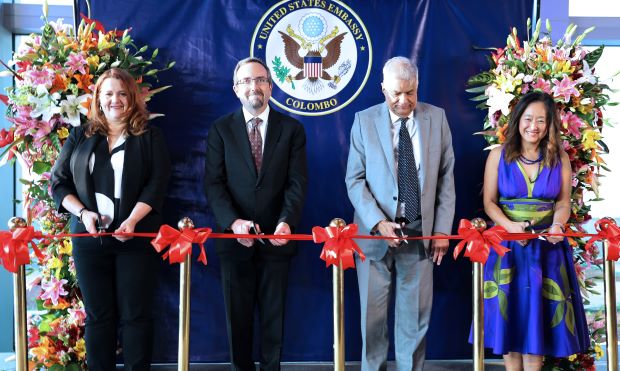COLOMBO – Celebrating more than 70 years of US-Sri Lankan friendship, partnership, and bilateral ties, the US Embassy in Sri Lanka officially opened its new premises on Galle Road on Friday (28), in a festive event attended by President Ranil Wickremesinghe, US Ambassador to Sri Lanka, Julie Chung, and Under Secretary for Management, US Department of State, Under Secretary for Management, John Bass. Officials and private citizens from both countries also participated in the festivities.
Ambassador Chung noting that the US had had an embassy in Colombo since Sri Lanka’s independence in 1948, said the new premises symbolizes her country’s enduring partnership with Sri Lanka.
“Americans and Sri Lankans worked together to build this state-of-the-art facility that epitomizes respect for the environment and appreciation of Sri Lankan architectural, cultural, and artistic themes. We are pleased to open our new doors to our Sri Lankan friends,” she said.
Under Secretary Bass said the new embassy highlights the important diplomatic relationship between the United States and Sri Lanka and provides the first impression of the United States for many Sri Lankans. “It also demonstrates sustainable design, construction, and operations that represent the best of US architecture, engineering, and building standards,” he added.
The new embassy, situated on the existing, expanded embassy site along the seafront in central Colombo, provides a secure, modern, sustainable, and resilient platform for US diplomacy in Sri Lanka. The architecture and landscape of the new premises embraces Sri Lanka’s ecology, history, and culture and are heavily influenced by Colombo’s tropical climate. Domestically sourced natural stone and wood reference the region’s rich selection of materials in a neutral palette that draws attention to the lushness of the landscape. The embassy’s interior incorporates textures and patterns inspired by local culture, art, and the surrounding gardens.
A model of environmental stewardship, the new embassy was designed to reduce energy costs and greenhouse-gas emissions while increasing security and augmenting renewable energy usage. To mitigate the effects of strong sun and heavy rainfall, the new embassy integrates regionally available weather-resistant materials, an advanced storm-water management system, and, soon, photovoltaic arrays that will offset roughly 11% of the building’s annual energy use. The project is registered with Leadership in Energy and Environmental Design (LEED®) — a global green building certification program that recognizes best-in-class building strategies and practices — and is on track to achieve Silver certification.
The new embassy also contains a permanent art collection, curated by the Office of Art in Embassies, and includes art in a variety of media, including painting, photography, textiles, and sculpture by both US and Sri Lankan artists. Highlights include site-specific commissions of Birds for Sri Lanka and a wall sculpture representing the atolls and coral life in the oceans. These works reflect an understanding of the diversity and richness of US and Sri Lankan ecology and cultural heritage.
The Bureau of Overseas Building Operations spearheaded the new embassy’s construction. Integrus Architecture of Seattle was the architect for the project, and Caddell Construction Company, LLC of Montgomery, Alabama, constructed the complex, injecting roughly $90 million into the local economy.
-US Embassy/ENCL



Comments are closed, but trackbacks and pingbacks are open.